Geography Playlist
19 chapters • 0 completed
The Universe and the Earth
18 topics
Atmosphere and its composition
6 topics
Atmospheric Temperature
11 topics
Atmospheric Moisture
9 topics
Air Mass, Fronts & Cyclones
15 topics
Evolution of Earths Crust, Earthquakes and Volcanoes
23 topics
Interior of The Earth
14 topics
Landforms
25 topics
Geomorphic Processes
10 topics
Movement of Ocean Water
16 topics
Oceans and its Properties
12 topics
Climate of a Region
14 topics
Indian Geography - introduction, Geology
5 topics
Physiography of India
27 topics
Indian Climate
20 topics
Indian Drainage
32 topics
Soil and Natural Vegetation
13 topics
Mineral and Energy Resources, Industries in India
28 topics
Indian Agriculture
22 topics
Chapter 10: Movement of Ocean Water
Chapter TestMovement of Ocean Water – Tides
Tides are the periodic rise and fall of sea level caused mainly by the gravitational pull of the moon and, to a lesser extent, the sun, combined with Earth’s rotation. They create high tides, low tides, tidal ranges, and tidal currents that influence coastal dynamics.
Tides are the periodic rise and fall of sea level caused mainly by the gravitational pull of the moon and, to a lesser extent, the sun, combined with Earth’s rotation. They create high tides, low tides, tidal ranges, and tidal currents that influence coastal dynamics.
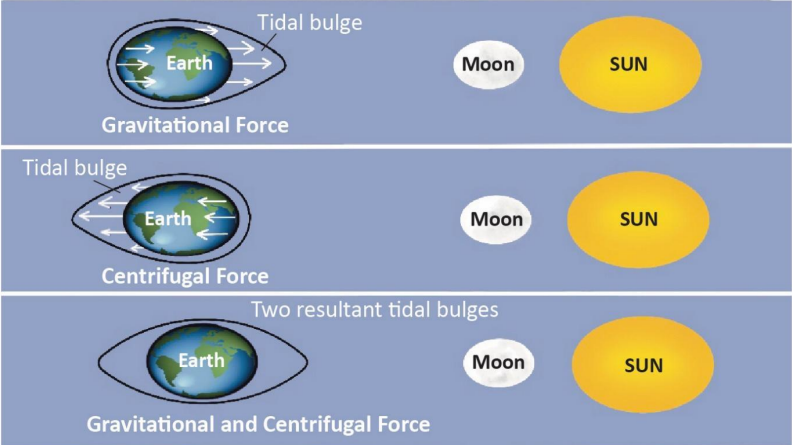
Key Aspects of Tides
| Term | Description |
|---|---|
| High Tide | When tide crest reaches the shore |
| Low Tide | When tide trough reaches the shore |
| Tidal Range | Height difference between high and low tide |
| Flood Current | Incoming tidal current towards land |
| Ebb Current | Outgoing tidal current away from land |
Mains Key Points
Prelims Strategy Tips
Types of Tides (Based on Frequency)
Tides are classified into semidiurnal, diurnal, and mixed based on their frequency and pattern of occurrence within a day.
Tides are classified into semidiurnal, diurnal, and mixed based on their frequency and pattern of occurrence within a day.
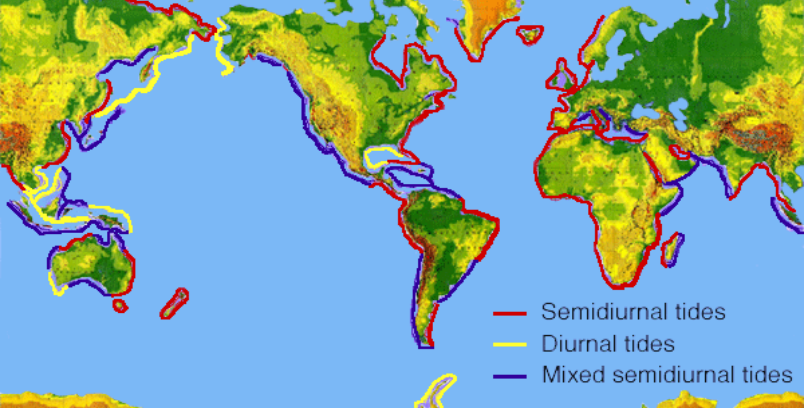
Types of Tides Based on Frequency
| Tide Type | Characteristics | Examples |
|---|---|---|
| Semidiurnal | Two high & two low tides daily; ~12h 26m apart; equal heights | Most common worldwide |
| Diurnal | One high & one low tide daily; ~24h 52m apart; equal heights | Gulf of Mexico, East Kamchatka |
| Mixed | Two highs & two lows daily; unequal heights | West coast of North America, Pacific Islands |
Mains Key Points
Prelims Strategy Tips
Types of Tides (Based on Height)
Spring tides occur when the Earth, Sun, and Moon align (syzygy), producing higher tides due to combined gravitational pull. Neap tides occur when the Sun and Moon are at right angles, resulting in weaker tides. Both occur twice a month with a 7-day interval.
Spring tides occur when the Earth, Sun, and Moon align (syzygy), producing higher tides due to combined gravitational pull. Neap tides occur when the Sun and Moon are at right angles, resulting in weaker tides. Both occur twice a month with a 7-day interval.

Spring Tides vs Neap Tides
| Aspect | Spring Tides | Neap Tides |
|---|---|---|
| Occurrence | New Moon & Full Moon (2 times/month) | First & Last Quarter Moon (2 times/month) |
| Position | Earth, Sun, Moon in straight line (syzygy) | Sun & Moon at right angles (90°) |
| Force | Combined Sun + Moon gravity | Solar pull partially cancels lunar pull |
| Height | About 20% higher than normal | Lower than normal tides |
| Interval | Occurs twice per month | Occurs twice per month, ~7 days after spring tide |
Mains Key Points
Prelims Strategy Tips
Tidal Bore & Significance of Tides
A tidal bore is a rare hydrological phenomenon caused when powerful tides travel upstream against a river current. Tides overall are vital for shaping coastal ecosystems, aiding navigation, supporting fishing, and generating renewable tidal energy.
A tidal bore is a rare hydrological phenomenon caused when powerful tides travel upstream against a river current. Tides overall are vital for shaping coastal ecosystems, aiding navigation, supporting fishing, and generating renewable tidal energy.
Major Tidal Bore Locations
| River/Location | Country | Height/Range |
|---|---|---|
| Qiantang River | China | Up to 9 m |
| Amazon (Pororoca) | Brazil | 4–5 m |
| Severn Estuary | UK | 2–3 m |
| Hooghly River | India | 2–3 m |
| Bay of Fundy | Canada | Tidal range ~16 m (no bore, but extreme tides) |
Mains Key Points
Prelims Strategy Tips
Ocean Currents
Ocean currents are continuous, large-scale movements of seawater driven by solar heating, wind, gravity, Coriolis force, salinity, and landmass orientation. They regulate climate, distribute nutrients, and influence human activities.
Ocean currents are continuous, large-scale movements of seawater driven by solar heating, wind, gravity, Coriolis force, salinity, and landmass orientation. They regulate climate, distribute nutrients, and influence human activities.
Examples of Warm and Cold Currents
| Type | Examples | Region |
|---|---|---|
| Warm Current | Gulf Stream | North Atlantic |
| Warm Current | Kuroshio Current | North Pacific |
| Warm Current | Brazil Current | South Atlantic |
| Cold Current | California Current | Eastern Pacific |
| Cold Current | Humboldt/Peru Current | South America Pacific coast |
| Cold Current | Canary Current | Northwest Africa |
Mains Key Points
Prelims Strategy Tips
Atlantic Ocean Circulation (North Atlantic)
The North Atlantic circulation is a clockwise gyre formed by the interaction of equatorial, Gulf Stream, Canary, and polar currents. It plays a crucial role in transferring warm water northward and cold water southward, influencing Europe’s climate and global thermohaline circulation.
The North Atlantic circulation is a clockwise gyre formed by the interaction of equatorial, Gulf Stream, Canary, and polar currents. It plays a crucial role in transferring warm water northward and cold water southward, influencing Europe’s climate and global thermohaline circulation.
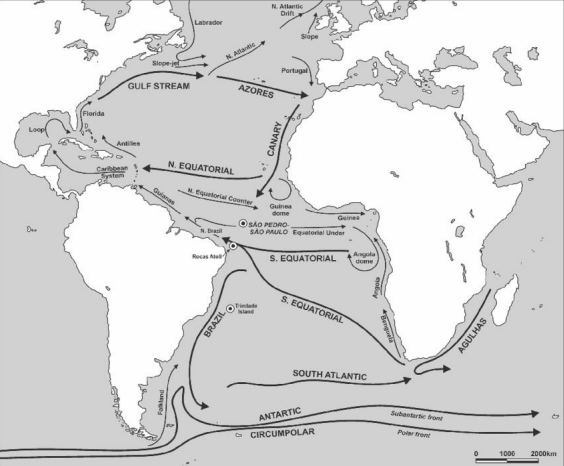
Major Currents of North Atlantic
| Current | Type | Direction/Region |
|---|---|---|
| North & South Equatorial | Warm | East to West along Equator |
| Cayenne Current | Warm | Along Guiana coast |
| Brazilian Current | Warm | South along Brazil coast |
| Florida Current / Gulf Stream | Warm | From Florida Strait to North Atlantic |
| North Atlantic Drift | Warm | Towards Europe & Arctic |
| Canary Current | Cold | South along NW Africa |
| Irminger Current | Cold | Between Iceland and Greenland |
| Labrador Current | Cold | Between Greenland and Baffin Island |
Mains Key Points
Prelims Strategy Tips
South Atlantic and Pacific Ocean Circulation
The South Atlantic circulation is anti-clockwise, driven by Equatorial, Brazilian, Benguela, and West Wind Drift currents. The Pacific Ocean circulation mirrors the Atlantic, but its vast size leads to more complex current systems like the Kuroshio, California, East Australian, and Oyashio currents.
The South Atlantic circulation is anti-clockwise, driven by Equatorial, Brazilian, Benguela, and West Wind Drift currents. The Pacific Ocean circulation mirrors the Atlantic, but its vast size leads to more complex current systems like the Kuroshio, California, East Australian, and Oyashio currents.
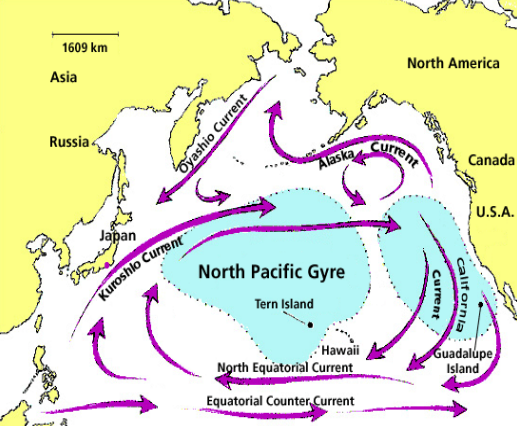
Major Currents of South Atlantic and Pacific
| Current | Ocean | Type | Region/Direction |
|---|---|---|---|
| Brazilian Current | South Atlantic | Warm | South along Brazil |
| Benguela Current | South Atlantic | Cold | NW along SW Africa |
| South Atlantic Current | South Atlantic | Warm | Eastward with Westerlies |
| South Equatorial Current | South Atlantic | Warm | Westward along Equator |
| Kuroshio Current | North Pacific | Warm | North along Japan |
| California Current | North Pacific | Cold | South along N. America |
| Oyashio Current | North Pacific | Cold | South from Bering Sea |
| East Australian Current | South Pacific | Warm | South along Australia |
| Peru (Humboldt) Current | South Pacific | Cold | North along S. America |
| Equatorial Counter Current | Pacific | Warm | Eastward along Equator |
Mains Key Points
Prelims Strategy Tips
Indian Ocean Circulation
The South Indian Ocean circulation resembles the Atlantic and Pacific gyres, while the North Indian Ocean is unique due to seasonal reversal of currents under monsoon winds.
The South Indian Ocean circulation resembles the Atlantic and Pacific gyres, while the North Indian Ocean is unique due to seasonal reversal of currents under monsoon winds.
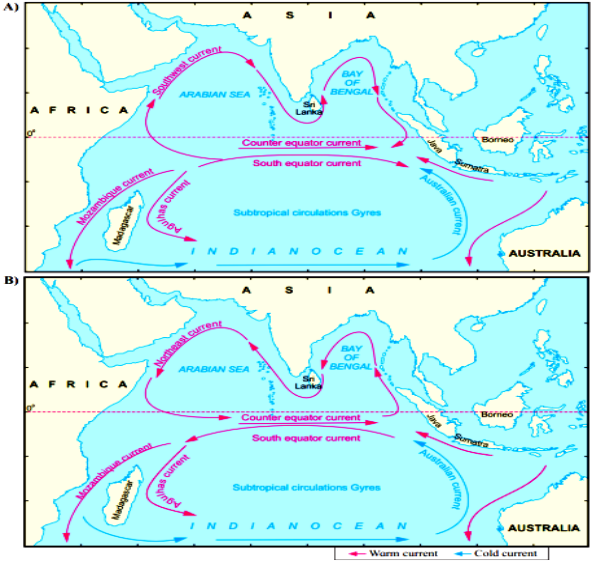
Major Currents of Indian Ocean
| Current | Region | Type | Seasonal Behavior |
|---|---|---|---|
| South Equatorial Current | Southern Indian Ocean | Warm | Flows westward year-round |
| Agulhas (Mozambique) Current | East Africa coast | Warm | Southward flow, year-round |
| West Australian Current | Western Australia | Cold | Northward, closes gyre |
| South-West Monsoon Drift | North Indian Ocean | Warm | Flows NE during summer (Jun–Oct) |
| North-East Monsoon Drift | North Indian Ocean | Cold | Flows SW during winter (Dec–Mar) |
| Somali Current | Somalia coast | Reversible | Warm & northward in summer; weak & southward in winter |
Mains Key Points
Prelims Strategy Tips
Important Warm Ocean Currents
Warm currents are generally western boundary currents that transport warm water from equatorial to higher latitudes, moderating climate and influencing rainfall patterns.
Warm currents are generally western boundary currents that transport warm water from equatorial to higher latitudes, moderating climate and influencing rainfall patterns.
List of Important Warm Currents
| Current | Ocean/Region | Key Facts |
|---|---|---|
| North Equatorial Current | Pacific & Atlantic | Flows east → west between 10°N and 20°N; forms southern side of subtropical gyres. |
| Kuroshio Current | Pacific | ‘Black Stream’; warm western boundary current, regulates Japan’s temperature; similar to Gulf Stream. |
| North Pacific Current | Pacific | Clockwise circulation in W. North Pacific; formed by Kuroshio & Oyashio convergence. |
| Alaskan Current | North Pacific | Northward diversion of North Pacific Current; creates Haida & Sitka eddies. |
| Equatorial Counter Current | Atlantic, Pacific, Indian | Flows west → east between 3°N and 10°N; wind-driven counter flow. |
| Tsushima Current | Sea of Japan | Branch of Kuroshio Current, flows into Sea of Japan. |
| South Equatorial Current | Atlantic, Pacific, Indian | East → west flow in Southern Hemisphere; driven by trade winds. |
| East Australian Current | South-West Pacific | Transports tropical marine fauna to subtropical SE Australia. |
| Florida Current | S. Atlantic & Caribbean | Discovered in 1513; flows around Florida Peninsula, joins Gulf Stream. |
| Gulf Stream | North Atlantic | Powerful western boundary current; splits into North Atlantic Drift & Canary Current. |
| Norwegian Current | North Sea & Barents Sea | Branch of North Atlantic Drift; carries warm water into Arctic. |
| Irminger Current | North Atlantic | Named after Carl Irminger; part of subpolar gyre, moderates Iceland-Greenland seas. |
| Antilles Current | North Atlantic | Flows across islands separating Atlantic & Caribbean; part of N. Atlantic gyre. |
| Brazilian Current | South Atlantic | Flows south along Brazil coast; meets Falkland Current at Rio de la Plata. |
| Mozambique Current | Indian Ocean | Flows in Mozambique Channel between Mozambique & Madagascar; forms large eddies. |
| Agulhas Current | SW Indian Ocean | Largest western boundary current; flows south along E. Africa. |
| Southwest Monsoon Current | North Indian Ocean | Seasonal; flows NE in Arabian Sea & Bay of Bengal (June–Oct). |
Mains Key Points
Prelims Strategy Tips
Important Cold Ocean Currents
Cold currents flow from higher latitudes (polar/sub-polar regions) towards the equator, bringing nutrient-rich waters that support some of the richest fisheries in the world.
Cold currents flow from higher latitudes (polar/sub-polar regions) towards the equator, bringing nutrient-rich waters that support some of the richest fisheries in the world.
List of Important Cold Currents
| Current | Ocean/Region | Key Facts |
|---|---|---|
| Canary Current | North Atlantic | Eastern boundary current; flows south along NW Africa; cools regions like Morocco; supports upwelling & fisheries. |
| Labrador Current | North Atlantic | Cold current flowing south between Greenland & Canada; meets Gulf Stream, creating foggy Grand Banks (rich fishing). |
| Oyashio Current | NW Pacific | Cold subarctic current flowing south from Bering Sea along Russia/Japan; meets warm Kuroshio → fog & rich fisheries. |
| California Current | NE Pacific | Eastern boundary current; flows south along US West Coast; cools California climate; upwelling zone → sardine fisheries. |
| Benguela Current | SE Atlantic | Flows north along SW Africa; cold upwelling zone supports rich fisheries (Namibia, South Africa). |
| Peru (Humboldt) Current | SE Pacific | Cold current along west coast of South America; rich in plankton; supports world’s largest anchovy fisheries; linked to El Niño. |
| Falkland Current | SW Atlantic | Cold current flowing north along east coast of S. America; meets Brazil Current near Rio de la Plata. |
| West Australian Current | Indian Ocean | Flows northward along western Australia; cooler current influencing desert climate (Perth region). |
| West Wind Drift | Southern Ocean | Largest current; flows endlessly east around Antarctica; mixes with other cold currents. |
Mains Key Points
Prelims Strategy Tips
Significance of Ocean Currents
Ocean currents act as a global conveyor belt – regulating climate, distributing nutrients, supporting marine biodiversity, shaping coastlines, and sustaining fisheries.
Ocean currents act as a global conveyor belt – regulating climate, distributing nutrients, supporting marine biodiversity, shaping coastlines, and sustaining fisheries.
Mains Key Points
Prelims Strategy Tips
Ocean-Atmospheric Interactions: El Niño & Southern Oscillation (ENSO)
El Niño is a periodic warming of sea surface temperatures in the central & eastern Pacific, disrupting global climate patterns. ENSO is the coupled system of oceanic warming (El Niño/La Niña) and atmospheric pressure changes (Southern Oscillation).
El Niño is a periodic warming of sea surface temperatures in the central & eastern Pacific, disrupting global climate patterns. ENSO is the coupled system of oceanic warming (El Niño/La Niña) and atmospheric pressure changes (Southern Oscillation).
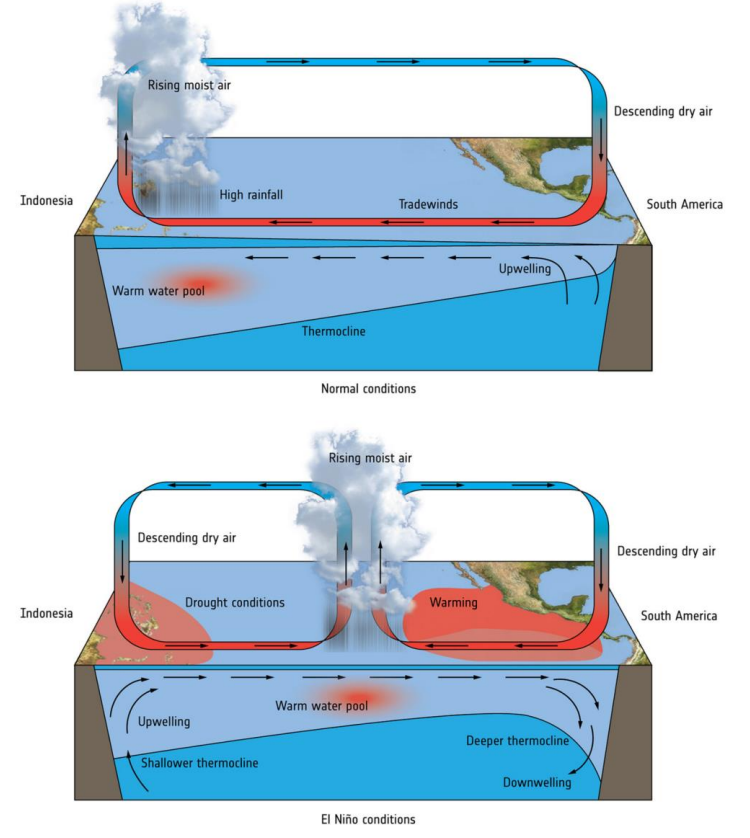
Normal Year vs El Niño Year
| Aspect | Normal Year | El Niño Year |
|---|---|---|
| Trade Winds | Strong, east → west | Weak/Reverse |
| Sea Surface Temperature (SST) | Cool in East Pacific (Peru, Ecuador) | Warm in East Pacific |
| Upwelling | Strong cold upwelling off Peru | Suppressed upwelling |
| Rainfall | Heavy over Indonesia & Australia | Drought in Australia, floods in Peru |
| Global Effect | Normal monsoons | Weakened monsoons in India, global anomalies |
Mains Key Points
Prelims Strategy Tips
Consequences of El Niño
El Niño disrupts global weather patterns: droughts in some regions, floods in others, weakened upwelling affecting fisheries, altered cyclone tracks, and weakened Indian monsoon.
El Niño disrupts global weather patterns: droughts in some regions, floods in others, weakened upwelling affecting fisheries, altered cyclone tracks, and weakened Indian monsoon.
Regional Impacts of El Niño
| Region | Impact |
|---|---|
| Australia & Indonesia | Drought, wildfires, crop losses |
| Peru & Ecuador | Heavy rainfall, floods |
| North America (North US & Canada) | Warmer, drier winters |
| US Gulf Coast & Southeast | Excess rainfall, flooding |
| Pacific Ocean | More cyclones |
| Atlantic Ocean | Fewer cyclones |
| India | Weak monsoon, drought, crop failure |
| Peru/Chile fisheries | Collapse due to weak upwelling |
Mains Key Points
Prelims Strategy Tips
La Niña
La Niña is the cold phase of ENSO, marked by unusual cooling in the central and eastern Pacific. It strengthens trade winds, enhances rainfall in western Pacific/Asia, and brings colder winters to Canada & Alaska, while drying the American Southeast.
La Niña is the cold phase of ENSO, marked by unusual cooling in the central and eastern Pacific. It strengthens trade winds, enhances rainfall in western Pacific/Asia, and brings colder winters to Canada & Alaska, while drying the American Southeast.
Comparison: El Niño vs La Niña
| Aspect | El Niño | La Niña |
|---|---|---|
| Pacific SST | Warming in central & eastern Pacific | Cooling in central & eastern Pacific |
| Trade Winds | Weaken | Strengthen |
| South America (Peru, Chile) | Heavy rainfall, weak fisheries | Dry weather, strong fisheries |
| Australia & SE Asia | Drought | Heavy rainfall, floods |
| India | Weak monsoon, drought | Stronger monsoon, floods |
| North America (Canada/Alaska) | Mild, dry winters | Cold, snowy winters |
| Cyclone Activity | ↑ in Pacific, ↓ in Atlantic | ↑ in Atlantic, ↓ in Pacific |
Mains Key Points
Prelims Strategy Tips
El Niño vs La Niña
El Niño is the warm phase of ENSO, marked by unusual warming of central & eastern Pacific waters, while La Niña is the cold phase, marked by unusual cooling. Both influence global climate, rainfall, fisheries, and monsoons in contrasting ways.
El Niño is the warm phase of ENSO, marked by unusual warming of central & eastern Pacific waters, while La Niña is the cold phase, marked by unusual cooling. Both influence global climate, rainfall, fisheries, and monsoons in contrasting ways.
Comparison of El Niño and La Niña
| Basis | El Niño | La Niña |
|---|---|---|
| Meaning | ‘Little Boy’ or Christ Child (Spanish) | ‘Little Girl’ (Spanish) |
| Sea Surface Temperature | Warming in east-central Pacific | Cooling in east-central Pacific |
| Pressure | High surface pressure in western Pacific | Low surface pressure in eastern Pacific |
| Formation | Weak trade winds, warm water pushed east, weaker Walker cell | Strong trade winds, warm water pushed west, stronger Walker cell |
| Period of Occurrence | Every 3–5 years, lasts 9–12 months | Every 3–5 years, lasts 1–3 years |
| Impacts (Global) | Drought in eastern Australia, floods in western South America, weak upwelling near Peru | Excessive rainfall in eastern Australia, drought in South America, strong upwelling near Peru |
| Impact on Indian Monsoon | Weak monsoon → up to 70% rainfall reduction | Stronger/better monsoon rains in India |
Mains Key Points
Prelims Strategy Tips
Indian Ocean Dipole (IOD)
IOD is a climate phenomenon in the Indian Ocean characterized by periodic oscillation of sea-surface temperatures between the western and eastern parts. It influences Indian monsoon, rainfall distribution, and global weather patterns.
IOD is a climate phenomenon in the Indian Ocean characterized by periodic oscillation of sea-surface temperatures between the western and eastern parts. It influences Indian monsoon, rainfall distribution, and global weather patterns.
Phases of Indian Ocean Dipole
| Phase | Western Indian Ocean | Eastern Indian Ocean | Impact on India |
|---|---|---|---|
| Positive IOD | Warmer than normal | Cooler than normal | Stronger SW Monsoon, good rainfall |
| Negative IOD | Cooler than normal | Warmer than normal | Weak SW Monsoon, drought risk |
| Neutral IOD | Normal | Normal | Near-normal monsoon |
Mains Key Points
Prelims Strategy Tips
Chapter Complete!
Ready to move to the next chapter?
